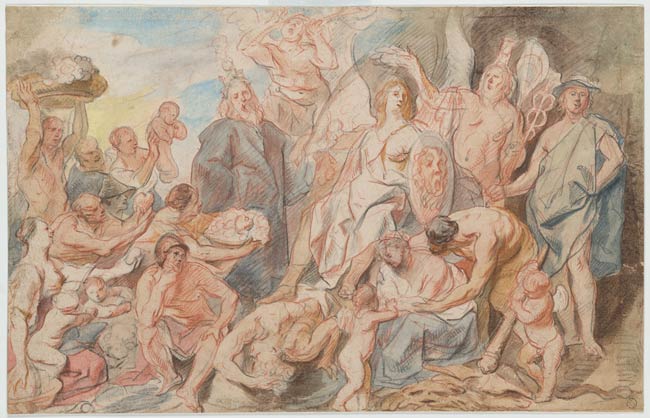
The complicated composition probably illustrates the victory of Minerva, goddess of wisdom-- identifiable by her shield with the head of Medusa--over the helmeted god of war, Mars, to her left, and his combative follower beneath her foot. As a result, Mercury (the god of commerce, at far right), is cheerful and Chronos (the personification of time, with his hourglass and scythe) presents laurels to Minerva: periods of peace bring about prosperity and well-being. No related painting is known, but Jordaens may have used the composition for one of the eleven paintings, of which only two survive, that he executed around 1665 for the ceiling of the Guild of St. Luke, temple of the arts in Antwerp. Indeed, if commerce is not protected from war, the arts cannot flourish. -- Exhibition Label, from "Power and Grace: Drawings by Rubens, Van Dyck, and Jordaens"
Traces of computations at lower right margin, probably by the artist, in red chalk, "26 / 156".
Watermark: Grapes (Heawood 2097).
Greville, Charles, 1762-1832, former owner.
Warwick, George Guy Greville, Earl of, 1818-1893, former owner.
Murray, Charles Fairfax, 1849-1919, former owner.
Morgan, J. Pierpont (John Pierpont), 1837-1913, former owner.
Tuinen, Ilona van. Power and Grace : Drawings by Rubens, Van Dyck, and Jordaens. New York : Morgan Library & Museum, 2018, no. 15 (repr.)
Collection J. Pierpont Morgan : Drawings by the Old Masters Formed by C. Fairfax Murray. London : Privately printed, 1905-1912, III, 171.
Stampfle, Felice, with the assistance of Ruth S. Kraemer and Jane Shoaf Turner. Netherlandish Drawings of the Fifteenth and Sixteenth Centuries and Flemish Drawings of the Seventeenth and Eighteenth Centuries in the Pierpont Morgan Library. New York : Pierpont Morgan Library, 1991, p. 131, no. 285, repr.
